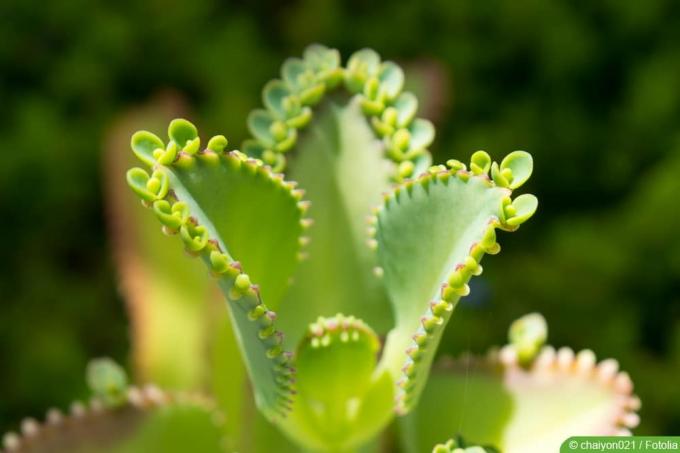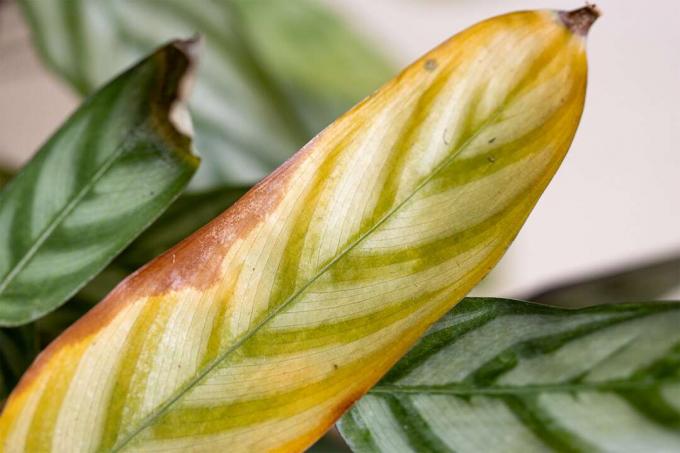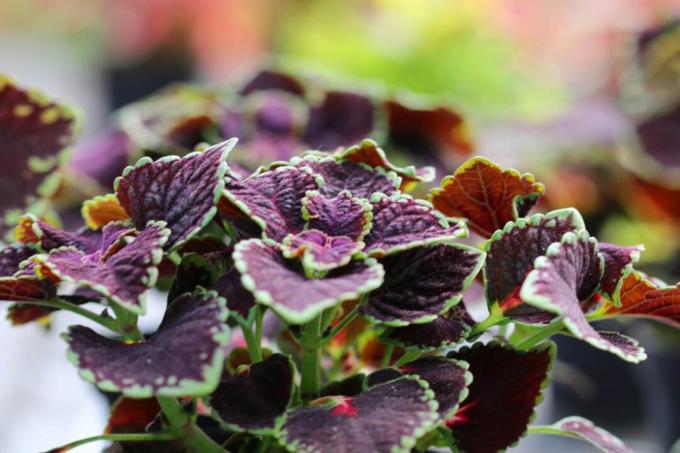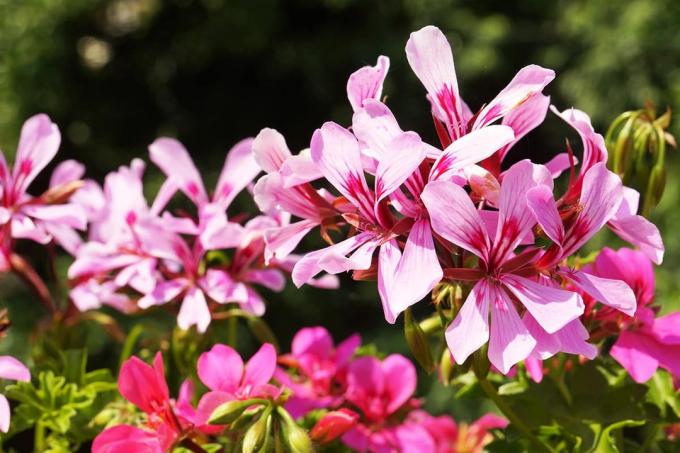

Table of contents
- Characteristics
- Location
- Floor
- Best planting time
- Planting / potting
- repot
- Pour
- Fertilize
- Cut
- wintering
- propagation
- offshoot
- head cuttings
- leaf cuttings
- seed
- Diseases
- pests
The bryophyllum (botanical: Bryophyllum) is primarily known as a medicinal plant. As an ornamental plant, it is characterized by its thick fleshy leaves, unusual leaf edges and attractive flowers. The Goethe plant makes few demands on care. Everything there is to know about it, from location to pruning and overwintering to propagation and disease, can be read below.
Characteristics
- Name: brood leaf
- Scientific Name: Bryophyllum / Kalanchoe tubiflora
- Trivial names: Goethe plant, energy plant, miracle leaf
- Genus: Kalanchoe
- Plant family: Crassulaceae
- Origin: Madagascar (Morocco)
- Growth height: between 80 and 130 centimeters depending on the species
- Flowering time: spring and, depending on species and lighting, in winter
- Biennial or perennial succulent plant
- Not hardy
Location
The brood leaf is used to temperatures in the warmer range from its original home, which is why it does not cope well with the cold climatic conditions in Central Europe. She likes to spend the summer outdoors. If the temperatures drop in late summer/autumn, it will thrive in a suitable location in the house. The ideal location has the following characteristics:
- Bright with no direct sunlight
- Sunny to semi-shady
- Protected against wind and rain
- Maximum moderate humidity
- South-west orientation ideal
- Also feels at home in rock gardens
Floor

Soil quality has a significant influence on growth, because it takes care of the goethe plant and keeps it alive. This is best done when the soil meets certain conditions:
- water permeable
- Loose and light
- porous structure
- Slightly calcareous
- Slightly sandy
- pH value: between 6.0 and 7.2 depending on the species
- pH Kalanchoe tubiflora: between 6.2 to 6.8
Tip:
The ideal substrate is cactus soil, the quality of which can easily be produced from normal potting soil by adding clay granules and sand in a ratio of 1:1.
Best planting time
The optimal time for planting a brood leaf is in March. In early spring, the growing season begins, which clearly promotes the establishment/rooting of the Kalanchoe. In addition, the energy content increases here, so that it can handle the stress of transplanting better. Planting in autumn is not advisable because from late summer it slowly prepares for hibernation and the metabolism begins to slow down. It would be less able to cope with the stress of being planted.
Planting / potting
Planting in the garden soil is usually only considered for larger specimens, but often not carried out because the Goethe plants are not hardy and have to be dug up again before the first frost are. For this reason, the brood leaf and especially the Kalanchoe tubiflora are usually only planted in tubs or pots. This happens as follows:
- Choose the bucket/pot size so that the roots fit in without buckling
- The diameter should allow plenty of room for lateral unfolding
- Cover the bottom of the bucket/pot two centimeters with broken pottery, gravel or quartz sand (drainage)
- Fill some soil over it
- Place the roots of the plant in a container filled with water until the roots are soaked
- Before planting, drain the roots well
- Then insert in the middle
- Fill up the substrate all around and press lightly again and again
- Keep a distance of about 2 centimeters from the edge of the bucket/pot so that water does not run out
- Pour lightly
Tip:
Clay pots/buckets are ideal because they are more permeable to air than plastic products, for example. This has the advantage that moisture can penetrate to the outside, while with plastic materials the moisture remains inside and the risk of rot increases here.
repot
Repotting should take place at the latest when the roots press towards the drain opening or are already peeking out. This is the sign that the tub/pot has become too small. The new pot/bucket should be between two and five centimeters larger in diameter. If there are no roots, it is advisable to repot the brood leaf every three years or to exchange the old soil for new ones. The substrate quality deteriorates over time, which can lead to supply disruptions. To prevent this, a change should be carried out every three years. Will be repotted in March.
Pour

The Goethe plant places the greatest demands on watering when it comes to care. It reacts so sensitively to too much water or even waterlogging that it can even die. It is therefore essential to refrain from uncontrolled, massive watering and to avoid waterlogging. A pot/bucket with a drainage hole is recommended here, from which excess water can escape. Make sure that any saucers that are used are emptied/dried after watering so that the pot/bucket does not remain in the water. Further details should be considered:
- It is better to water less, but more often
- Always allow the soil to dry slightly
- Never “re-water” vigorously if watering is forgotten (copes well with limited drought)
- Do not water in direct sunlight - risk of burns
- In winter, the water requirement drops significantly, but still needs to be watered from time to time
- Always water the bottom area
- Foliage does not require spraying - tolerates low humidity well
- Use lukewarm water
- Hard water will leave white spots on foliage over time
Fertilize
If a goethe plant/Kalanchoe tubiflora has been planted or transplanted into fresh substrate in the current year, it is not necessary to fertilize it that year. The new substrate provides sufficient nutrients for plant care. Fertilization is therefore only carried out from the second year - if desired, because fertilization is usually necessary in principle not mandatory as long as no visible growth and/or developmental disorders are noticed are. If you still want to fertilize to support health and flowering, you should follow the instructions below:
- Fertilizing period: from June to August
- Fertilizer rhythm: every four to six weeks
- Fertilizer: liquid cactus fertilizer
- Strictly follow the manufacturer's dosage recommendations
- The rule is "less is more" - too much fertilizer damages the plant
- Never fertilize in winter
Cut
The Bryophyllum is one of the fast-growing plants, which is why it can get a little "out of shape" over time. This can be corrected with a shape cut. Another reason to prune is to prevent parts of the plant from drying out. If you want to behave correctly when cutting, proceed as follows:
- Only use sharp, disinfected cutting tools
- Cut back no more than a third (except in the case of illness)
- Best time: Spring before growth begins - ideal for repotting
- Treat interfaces with wound closure (carbon powder or resin) - otherwise there is a risk of infection!
- Wipe away any sap that spills
A NOTICE:
Although the Kalanchoe tubiflora is not poisonous, there are some species among the brood leaves that can cause symptoms of poisoning, especially in small children and pets. Therefore, the following applies: avoid any direct skin contact and, above all, avoid consuming the plant sap.
wintering
During the winter months, the Bryophyllum does not need any special care, but is happy to accept it. This means that it can normally remain as a houseplant in a heated room, but is happy about a cooler location. For plants that have spent the summer outdoors, the right time to move to warmer climes depends on how many degrees Celsius they will be wintering at. If the heated living room is waiting for them, it is advisable to move them from outside by the end of August at the latest - if they overwinter in a cool place, they can stay outside until the onset of frost. This means that it is not exposed to high temperature differences, which it does not tolerate well. Other criteria should be considered for wintering:
- Do not put cooler than 16 to 18 degrees Celsius
- Winter location can be bright - if it is a little darker, it flowers often
- Do not fertilize and only water when the soil has dried well
- Retreating outdoors in spring only in stages to get used to the sun (risk of sunburn)
- The ideal time to retreat outdoors: after the ice saints
propagation

Bryophyllum reproduces itself by independently forming many offshoots during its existence. If left unattended, the offshoots will develop on the mother plant and lead to an opulent appearance with increasing width. If you want to grow independent, new plants, use the offshoots for propagation. Other options are available for propagation and can be easily implemented using the local professional instructions.
offshoot
Offshoots emerge from the soil, where they are usually connected to the mother plant underground. This type of propagation is considered the simplest and most promising. How it works:
- Best time: between April and June/July
- Expose soil on the surface in the area of the offshoot
- Kindel with small roots should be between 0.3 and 0.8 millimeters long
- Separate offshoots directly from the mother plant with a sharp knife
- Fill a small pot with high-quality, sandy substrate
- Put offshoots in the ground and press them down lightly for more stability
- Water moderately
- Water less than an adult plant, but never let it dry out completely
- Never fertilize in the first year
- Location: bright at temperatures around 20 degrees Celsius
- From the age of two care as for adult Goethe plants
head cuttings
The chances of success of propagation are also good with the use of cuttings. This species is mainly used when the mother plant loses its attractive appearance due to dying leaves. That is how it goes:
- Use the top cutting and separate it from the mother plant to the desired length
- Set the cut at an angle because then more moisture and nutrients can be absorbed from the soil
- Allow the cuttings to air dry for a day or two (reduces the risk of rotting)
- Then stick in dry substrate
- Pour the soil only minimally and then always allow the soil to dry well before watering again
- Location: sunny without direct sunlight
- Ideal ambient temperature: around 20 to 22 degrees Celsius
- The ideal time to propagate cuttings: Spring/May
leaf cuttings
Not all species are suitable for propagation by leaf cuttings. However, the Kalanchoe tubiflora is predestined for this because it is one of the few that has brood buds on the Leaves and therefore there is a lot of energy in this plant area, which is conducive to an independent life is. Although this type of propagation is less promising, it still works in many cases. This is how it's done:
- Cut off the leaf at the lowest point
- Choose a pot in which the leaf fits completely lengthwise
- Fill the pot with potting soil and place the leaf on top
- It is pressed lightly, but not pushed into the ground
- Spray the soil and leaf lightly with lime-free water every day
- Soil must not be too moist or dry out
- Stretch translucent foil over pot
- Location: bright at least 18 degrees Celsius
- Rooting: after about ten days - sometimes longer
- As soon as a child has formed, plant in normal soil as described under "Offshoots".
seed

The seeds of brood leaves are light germinators. That is, the seeds are simply placed on the ground without covering them with soil. Cultivation soil is to be used as soil. The procedure is as follows:
- Distribute seeds on potting soil
- Only slightly moisten the soil with a sprayer
- Stretch foil over it to increase humidity
- Don't let the soil dry out
- Location: warm and bright with no direct sunlight
- Best time: spring to summer
- Germination time: between 14 and 30 days
- Remove foil after germination
- Transplantation: as soon as the little plant has reached three to four centimeters in height
- Allow to overwinter at room temperature during the first winter
Diseases
The Goethe plant is very robust against diseases. It is usually due to incorrect or too well-intentioned care in the area of watering. Excessive moisture can quickly lead to rot. If the above-ground parts of the plant are soggy, the brood leaf can usually no longer be helped. If a bad odor rises from the ground and only the root is affected, the following measure can mean salvation:
- Pot up the plant immediately
- Remove roots from wet soil as much as possible
- Cut off completely soaked roots
- Cut the rest by a third
- Allow roots to air dry for 24 hours
- Plant back into fresh, dry soil
- After three to four days, moisten the soil minimally
- Water regularly after ten days, but significantly less than the amount that caused the rot
pests
As insensitive as the Bryophyllum is to diseases, it rarely attracts pests. Nevertheless, an infestation of aphids, mealybugs or mealybugs can occasionally occur. They are easy to get rid of with a household remedy: soapy water!
- Stir 200 milliliters of soft soap or washing-up liquid into one liter of water
- Add a dash of spirit to boost the effect
- Pour lye into a spray pump
- Spray dripping wet on all sides
- Repeat every two days
- Duration of use: about eight to ten days
 garden editorial
garden editorial I write about everything that interests me in my garden.
Learn more about houseplants

Calathea has yellow leaves: how to save?
When a Coriander (Calathea) gets yellow leaves, the cause is usually a lack of care. In order to save them from dying, a number of countermeasures must be taken, which are described in detail here.

Room bamboo: 13 tips for care
The room bamboo impresses with its compact growth habit and is a densely grown houseplant. The ten most important tips for caring for the sweet grass are compiled for you here.

Coleus blumei: 21 tips for the red nettle
The colored nettle is a warmth-loving and easy-care foliage plant. The coloring of the leaves varies from monochromatic to variegated with a wide variety of drawings. Spectacular splashes of color can be set in beds, balcony boxes and tubs or as a houseplant.

Scented houseplants: 25 scented plants for the home
An apartment without indoor plants is hardly conceivable. Scented plants in particular have a very special effect. Not only are they decorative, they can lighten the mood and rival any artificial home fragrance.

Lucky chestnut, Pachira aquatica: care from A to Z
The care of the lucky chestnut does not require any special expertise. However, if you know the way of life of this ornamental plant, you can better adapt site conditions and care measures to your needs. The plant can be easily propagated if a plant already exists.

Rubber tree: 13 care tips for Ficus elastica
The rubber tree is one of the most popular indoor plants. It is available in different varieties, easy to care for and stands out for its large leaves, which are colored in intense shades of green. Within a few years, it grows into a state small tree without much effort.



